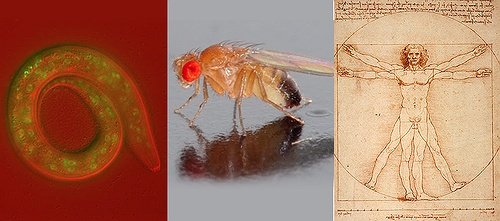Cold Spring Harbor, NY - September 8, 2014 - Researchers analyzing human, fly, and worm genomes have found that these species have a number of key genomic processes in common, reflecting their shared ancestry. The findings, appearing in the journal Nature, offer fresh insights into embryonic development, gene regulation and other biological processes vital to understanding human biology and disease.
The studies highlight the data generated by the modENCODE Project and the ENCODE Project, both supported by the National Human Genome Research Institute (NHGRI), part of the National Institutes of Health. The goal of modENCODE has been to create a comprehensive catalog of functional elements in the fruit fly and roundworm genomes for use by the research community. This work complements that of the ENCyclopedia Of DNA Elements (ENCODE) Project, which is building a comprehensive catalog of functional elements in the human and mouse genomes.
Cold Spring Harbor Laboratory (CSHL) Professor Thomas Gingeras has been a leader of the modENCODE effort, and led CSHL researchers in both experimental and analytical aspects of human genome work that provided some of the most arresting perspectives in the newly published papers.
As noted by Gingeras’ co-principal investigator Mark Gerstein, Ph.D., of Yale University, “One way to describe and understand the human genome is through comparative genomics and studying model organisms.” One key point is that since the worm and fly “are very distant from humans evolutionarily, finding something conserved across all three – human, fly and worm – tells us it is a very ancient, fundamental process.”
In one of the newly published modENCODE studies, scientists led by Gerstein, Gingeras and others analyzed human, fly and worm transcriptomes, the sum total of messages sent by genes, which include instructions to manufacture proteins, as well as molecules that regulate when and where other genes are expressed. The scientists used large amounts of gene expression data generated in the ENCODE and modENCODE projects – including more than 67 billion gene sequence readouts – to discover gene expression patterns shared by all three species, particularly for developmental genes.
Investigators showed that the ways in which DNA is packaged in the cell are similar in many respects, and, in many cases, the species share programs for turning on and off genes in a coordinated manner. They used gene expression patterns to match the stages of worm and fly development and found sets of genes that parallel each other in their usage.
The researchers found that in all three organisms, the gene expression levels for both protein-coding and non-protein-coding genes could be predicted from chromatin features at the promoters of genes. A gene’s promoter tells the cell’s machinery where to begin copying DNA into RNA, which can be used to make proteins. DNA is packaged into chromatin in cells, and changes in this packaging can regulate gene function.
Another group of scientists investigated how chromatin – DNA and its protein packaging -- is organized and how it influences gene regulation in the three species. Using both modENCODE and ENCODE data, scientists compared patterns of modifications in chromatin that are needed for the cell to access the DNA inside, and the changes in DNA replication patterns as a result of these modifications. The investigators discovered that many features of chromatin were similar in all three species.
In a third study, scientists explored similarities in genome regulation. They focused on transcription-regulatory factors, key protein regulators that determine which progenitor cells eventually become skin cells and kidney cells and eye cells.
This collection of papers is the culmination of the modENCODE program, for which funding ended in 2012. More than 100 papers using modENCODE data by groups outside of the program have already been published. It is anticipated that the data will continue to be used by the broader research community for years to come.
“Comparative analysis of the transcriptome across distant species” appeared in Nature August 28, 2014. The full list of authors, in addition to CSHL’s Thomas R. Gingeras, as well as the full paper, can be obtained here. Other related papers can be found in the same issue of Nature.
This research was made possible by funding from the NHGRI, the NIH, and the U.S. Department of Energy, among others.
NHGRI is one of the 27 institutes and centers at the National Institutes of Health. The NHGRI Extramural Research Program supports grants for research and training and career development at sites nationwide. Additional information about NHGRI can be found at genome.gov.
About the National Institutes of Health (NIH):
NIH, the nation’s medical research agency, includes 27 institutes and centers and is a component of the U.S. Department of Health and Human Services. NIH is the primary federal agency conducting and supporting basic, clinical, and translational medical research, and is investigating the causes, treatments, and cures for both common and rare diseases. For more information about NIH and its programs, visit nih.gov.
About Cold Spring Harbor Laboratory
Founded in 1890, Cold Spring Harbor Laboratory (CSHL) has shaped contemporary biomedical research and education with programs in cancer, neuroscience, plant biology and quantitative biology. CSHL is ranked number one in the world by Thomson Reuters for the impact of its research in molecular biology and genetics. The Laboratory has been home to eight Nobel Prize winners. Today, CSHL's multidisciplinary scientific community is more than 600 researchers and technicians strong and its Meetings & Courses program hosts more than 12,000 scientists from around the world each year to its Long Island campus and its China center. For more information, visit cshl.edu.











